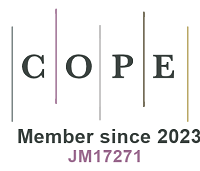REFERENCES
1. Commission delegated regulation (EU) 2020/217 of 4 October 2019 amending, for the purposes of its adaptation to technical and scientific progress, Regulation (EC) No 1272/2008 of the European Parliament and of the Council on classification, labelling and packaging of substances and mixtures and correcting that Regulation. Available from: https://eur-lex.europa.eu/eli/reg_del/2020/217/oj. [Last accessed on 4 Mar 2024]
3. Nielsen TD, Hasselbalch J, Holmberg K, Stripple J. Politics and the plastic crisis: a review throughout the plastic life cycle. Wiley Interdiscip Rev Energy Environ 2020;9:e360.
4. Laskar N, Kumar U. Plastics and microplastics: a threat to environment. Environ Technol Innov 2019;14:100352.
5. Xanthos D, Walker TR. International policies to reduce plastic marine pollution from single-use plastics (plastic bags and microbeads): a review. Mar Pollut Bull 2017;118:17-26.
6. Geyer R, Jambeck JR, Law KL. Production, use, and fate of all plastics ever made. Sci Adv 2017;3:e1700782.
7. Van L, Hamid NA, Ahmad F, Ahmad ANA, Ruslan R, Tamyez PFM. Factors of single use plastic reduction behavioral intention. Emerg Sci J 2021;5:269-78.
8. Spranz R, Schlüter A, Vollan B. Morals, money or the master: the adoption of eco-friendly reusable bags. Mar Policy 2018;96:270-7.
9. Nazareth M, Marques MRC, Leite MCA, Castro ÍB. Commercial plastics claiming biodegradable status: is this also accurate for marine environments? J Hazard Mater 2019;366:714-22.
10. Azevedo-Santos VM, Brito MFG, Manoel PS, et al. Plastic pollution: a focus on freshwater biodiversity. Ambio 2021;50:1313-24.
11. Huang W, Song B, Liang J, et al. Microplastics and associated contaminants in the aquatic environment: a review on their ecotoxicological effects, trophic transfer, and potential impacts to human health. J Hazard Mater 2021;405:124187.
12. He S, Jia M, Xiang Y, et al. Biofilm on microplastics in aqueous environment: physicochemical properties and environmental implications. J Hazard Mater 2022;424:127286.
13. Martínez-Campos S, González-Pleiter M, Rico A, et al. Time-course biofilm formation and presence of antibiotic resistance genes on everyday plastic items deployed in river waters. J Hazard Mater 2023;443:130271.
14. Rummel CD, Jahnke A, Gorokhova E, Kühnel D, Schmitt-Jansen M. Impacts of biofilm formation on the fate and potential effects of microplastic in the aquatic environment. Environ Sci Technol Lett 2017;4:258-67.
15. Lobelle D, Cunliffe M. Early microbial biofilm formation on marine plastic debris. Mar Pollut Bull 2011;62:197-200.
16. Balestri E, Menicagli V, Vallerini F, Lardicci C. Biodegradable plastic bags on the seafloor: a future threat for seagrass meadows? Sci Total Environ 2017;605-6:755-63.
17. Emadian SM, Onay TT, Demirel B. Biodegradation of bioplastics in natural environments. Waste Manage 2017;59:526-36.
18. O’Brine T, Thompson RC. Degradation of plastic carrier bags in the marine environment. Mar Pollut Bull 2010;60:2279-83.
19. Brandon J, Goldstein M, Ohman MD. Long-term aging and degradation of microplastic particles: comparing in situ oceanic and experimental weathering patterns. Mar Pollut Bull 2016;110:299-308.
20. Nauendorf A, Krause S, Bigalke NK, et al. Microbial colonization and degradation of polyethylene and biodegradable plastic bags in temperate fine-grained organic-rich marine sediments. Mar Pollut Bull 2016;103:168-78.
21. Kedzierski M, D’Almeida M, Magueresse A, et al. Threat of plastic ageing in marine environment. Adsorption/desorption of micropollutants. Mar Pollut Bull 2018;127:684-94.
22. Arias-Villamizar CA, Vázquez-Morillas A. Degradation of conventional and oxodegradable high density polyethylene in tropical aqueous and outdoor environments. Rev Int Contam Ambie 2018;34:137-47.
23. Chiellini E, Corti A, D’Antone S. Oxo-biodegradable full carbon backbone polymers - biodegradation behaviour of thermally oxidized polyethylene in an aqueous medium. Polym Degrad Stabil 2007;92:1378-83.
24. Adamcová D, Radziemska M, Fronczyk J, Zloch J, Vaverkova MD. Research of the biodegradability of degradable/biodegradable plastic material in various types of environments. Sci Rev Eng Environ Sci 2017;26:3-14.
25. Kalogerakis N, Karkanorachaki K, Kalogerakis GC, et al. Microplastics generation: onset of fragmentation of polyethylene films in marine environment mesocosms. Front Mar Sci 2017;4:84.
26. Tebaldi VMR, Souza AM, de Souza YHS, de Carvalho Alves JN, Piccoli RH. Evaluation of the levels of microbiological contamination of the water of the paraíba do sul river in the urban perimeter of Barra Mansa-RJ. Braz J Health Rev 2021;4:17138-53.
27. Rodrigues MO, Abrantes N, Gonçalves FJM, Nogueira H, Marques JC, Gonçalves AMM. Spatial and temporal distribution of microplastics in water and sediments of a freshwater system (Antuã River, Portugal). Sci Total Environ 2018;633:1549-59.
28. The sins of greenwashing: home and family edition. 2010. Available from: https://www.twosides.info/wp-content/uploads/2018/05/Terrachoice_The_Sins_of_Greenwashing_-_Home_and_Family_Edition_2010.pdf. [Last accessed on 4 Mar 2024]
29. de Souza AJ, de Araújo Pereira AP, Pedrinho A, et al. Land use and roles of soil bacterial community in the dissipation of atrazine. Sci Total Environ 2022;827:154239.
30. Sun Y, Ren X, Rene ER, et al. The degradation performance of different microplastics and their effect on microbial community during composting process. Bioresour Technol 2021;332:125133.
31. Lear G, Kingsbury JM, Franchini S, et al. Plastics and the microbiome: impacts and solutions. Environ Microbiome 2021;16:2.
32. Yuan J, Ma J, Sun Y, Zhou T, Zhao Y, Yu F. Microbial degradation and other environmental aspects of microplastics/plastics. Sci Total Environ 2020;715:136968.
33. Badea MA, Balas M, Dinischiotu A. Microplastics in freshwaters: implications for aquatic autotrophic organisms and fauna health. Microplastics 2023;2:39-59.
34. Wang Y, Zhou B, Chen H, Yuan R, Wang F. Distribution, biological effects and biofilms of microplastics in freshwater systems - a review. Chemosphere 2022;299:134370.
35. Jung MR, Horgen FD, Orski SV, et al. Validation of ATR FT-IR to identify polymers of plastic marine debris, including those ingested by marine organisms. Mar Poll Bull 2018;127:704-16.
36. Hammer J, Kraak MHS, Parsons JR. Plastics in the marine environment: the dark side of a modern gift. In: Witacre D, editor. Reviews of environmental contamination and toxicology. New York: Springer; 2012. pp. 1-44.
37. ASTM International. Standard guide for exposing and testing plastics that degrade in the environment by a combination of oxidation and biodegradation. Available from: https://www.astm.org/d6954-18.html. [Last accessed on 4 Mar 2024].







